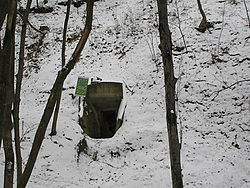| Optymistychna | |
|---|---|
 | |
| Location | near Ukrainian village of Korolivka, Chortkiv Raion, Ternopil Oblast |
| Coordinates | 48°44′33″N 25°59′37″E / 48.74250°N 25.99361°E / 48.74250; 25.99361 |
| Length | 230 km (140 mi) |
| Discovery | 1966 |
| Geology | gypsum |
| Website | optymistychna |
Optymistychna (Ukrainian: Оптимістична: meaning "optimistic", also known as Peschtschera Optimistitscheskaya) is a gypsum cave located near the Ukrainian village of Korolivka, Chortkiv Raion, Ternopil Oblast. Approximately 264 km (164 mi) of passageways have been mapped within. As a result, it is the longest cave in Europe and the seventh-longest cave in the world, after Mammoth Cave, Sistema Sac Actun, Jewel Cave, Shuanghedong and Sistema Ox Bel Ha. It is also the longest gypsum cave in the world.
History
The cave complex was discovered by members of the Lviv speleological club "Cyclope" in 1966. It was entirely unknown before then. There have been more than 50 expeditions since its discovery, but exploration has slowed significantly in recent years, and very little surveying is currently being done. The cave is located very close to the Priest's Grotto or Ozerna Cave, the eleventh-longest cave in the world at 130.4 km (81.0 mi), but the two caves have not yet been found to be connected.
In 2008, the cave was recognized as a Natural Wonder of Ukraine.
Geology

The entire cave lies under a 2 km square area in a layer of Neogene period gypsum that is less than 30 metres (98 ft) thick. The passages tend to be fairly small, no more than 3 metres (10 ft) wide and 1.5 metres (5 ft) tall for most, although at intersections they can be up to 10 metres (33 ft) tall. They are often choked with mud. They comprise a dense network on several levels, making Optymistychna known as a "maze cave".
Optymistychna's gypsum bed is topped with a limestone layer, which has seeped through into the cave via erosion and formed into calcite speleothems. At other places, the gypsum has formed crystals, often tinted a multitude of colors by mineral salts. In some areas, large gypsum rosettes have formed, colored black by manganese oxide.
Notes
- This English transliteration was used during the Soviet era but is now deprecated.
See also
References
- ^ White, William Blaine; Culver, David C. (2012). Encyclopedia of Caves. Academic Press. p. 830. ISBN 9780123838322.
- Herb, Jan Conn (1977). The Jewel Cave Adventure: Fifty Miles of Discovery under South Dakota. p. 230. ISBN 0-914264-20-6.
- ^ "Optimistic cave. Speleotourism. Active and extreme tourism. Travel". www.cave-ua.narod.ru. Retrieved 28 June 2017.
- Guden, Bob. "World's Longest Caves". Caver Bob. Archived from the original on 15 May 2006. Retrieved 5 November 2020.
- "OPTYMISTYCHNA IS THE LONGEST CAVE IN UKRAINE - Information Portal Good News". ukrainegoodnews.com. Retrieved 28 June 2017.
- Guden, Bob. "World's Longest Caves". Caver Bob. Archived from the original on 15 May 2006. Retrieved 5 November 2020.
- ^ Scheffel, Richard L.; Wernet, Susan J., eds. (1980). Natural Wonders of the World. United States of America: Reader's Digest Association, Inc. pp. 282. ISBN 0-89577-087-3.
- Optimistic Caves Archived 2009-03-24 at the Wayback Machine
- Warren, John K. (18 May 2016). Evaporites: A Geological Compendium. Springer. p. 677. ISBN 9783319135120.
External links
- Official website
- Chapter II.9, Gypsum Karst in the Western Ukraine by Alexander Klimchouk article appearing in: International Journal of Speleology, vol. 25, #3-4, 1996, p. 263-278.
| Seven Wonders of Ukraine | |
|---|---|
| Historical | |
| Natural | |
| Architectural | |
| Kyiv | |